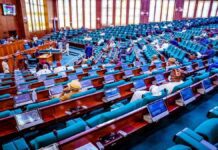Politics
Top Stories
Business & Finance
NDIC Increases Maximum Deposit Insurance Coverage for Failed Banks
NDIC Increases Maximum Deposit Insurance Coverage for Failed Banks
The Nigeria Deposit Insurance Corporation (NDIC), has reviewed upward the maximum deposit insurance coverage for depositors...
UBA’s Leo Celebrates 6 Years of Impact, With New Offerings
United Bank for Africa (UBA) Plc is celebrating the 6th year of operation of its flagship artificial intelligent Digital Assistant and Chatbot - Leo, and has announced new offerings aimed towards deepening the face of digital banking in Nigeria.
Fidelity Bank to Raise N32bn from Shareholders
Fidelity Bank Plc has proposed a capital raise of N32 billion from its shareholders to drive the lender’s growth agenda for the financial year 2024.
Moniepoint Introduces New Initiative to Reward Customers
Moniepoint Microfinance Bank (MfB) has introduced a new initiative “Moniepoint Personal Banking Refer and Earn” programme aimed at rewarding its customers this Christmas season.
Insurance Companies Collect N729.1bn Premium in First Three Quarters of 2023
Insurance companies collected N729.1 billion as premium in the first three quarters of 2023, an increase of N196 billion over the N532.7 billion collected in the first three quarters of 2022.
Economy
News
Sports
Chelsea Win Over Tottenham in Premier League Clash
Chelsea Win Over Tottenham in Premier League Clash
In a thrilling Premier League encounter at Stamford Bridge, Chelsea secured a convincing 2-0 victory against Tottenham...
Technology
Cryptocurrency
Health
Features
Entrepreneurship
Fubara vows to end era of fiscal recklessness in Rivers
Gov. Siminalayi Fubara of Rivers on Thursday in Elele vowed to ensure prudent management of the state’s revenue
FG to pay N130bn as part of gas supply debt – Minister
The Federal Government says it will soon begin the payment of N130 billion as part of gas supply debts in the Nigerian Electricity Supply
Emirates resumes Nigeria service Oct. 1 after 23 months
Emirates Airlines on Thursday announced that it will resume its Lagos, Nigeria services on Oct. 1, operating a daily service between
FG set to inaugurate NDDC’s N8.1bn Ondo electricity project
The Federal Government is to inaugurate the N8.1 billion Niger Delta Development Commission (NDDC) electricity project in Erinje



























































































